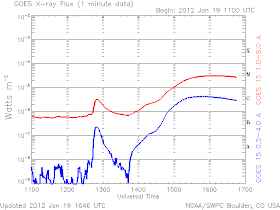Looking at the ACE data, we can see that the CME associated with the Jan 27th X1.7 flare has arrived at arround 15:40 UTC. This CME is expected to only give a glancing blow and not create a geomagnetic storm. We will keep an eye on the ACE data and report if conditions increase or change.
Original X1.7 flare report:
http://mysolaralerts.blogspot.com/2012/01/x17-flare-january-27-2012.html
NOAA Alert:
Issue Time: 2012 Jan 30 1653 UTC
SUMMARY: Geomagnetic Sudden Impulse
Observed: 2012 Jan 30 1624 UTC
Deviation: 8 nT
Station: Boulder
2012-01-30 17:15 CME Arrival at Earth from the X1-solar flare
A pulse in the solar wind passed the ACE spacecraft around 1540 UTC (10:40 EST) today. This abrupt increase in speed and magnetic field strength is thought to be from a CME on Friday, January 27. No significant geomagnetic storm activity is expected from this. Another effect of Friday's eruption, a Solar Radiation Storm, continues its leisurely decay and is nearing the end of the event (currently at S1 (Minor) levels).
http://www.swpc.noaa.gov/




.gif)



.gif)




































